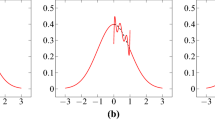Abstract
In the present work, some characterization results are established based on the number of observations near the order statistics. Under some conditions, it is shown that the parent distribution can be uniquely determined by the moments of the number of observations in a random sample that fall within a left-hand or right-hand neighborhood of a specific order statistic. It is proved that the underlying distribution \(F\) belongs to the class of symmetric distributions if and only if the first moment of the number of observations in the right neighborhood of the \(k\)th order statistic and in the left neighborhood of the\((n-k+1)\)th order statistic from a sample of size \(n\) are equal. Also, characterizations of the exponential distribution are presented.
Similar content being viewed by others
References
Akbari M, Fashandi M (2014) On characterization results based on the number of observations near the \(k\)-records. Statistics 48:633–640
Arnold BC, Balakrishnan N, Nagaraja HN (2008) A first course in order statistics. Unabridged republication of the 1992 original. Classics in applied mathematics, No. 54. Society for Industrial and Applied Mathematics (SIAM), Philadelphia
Balakrishnan N, Basu AP (eds) (1995) The exponential distribution: theory, methods and applications. Gordon & Breach Science Publishers, Newark
Balakrishnan N, Stepanov A (2005) A note on the number of observations near an order statistic. J Stat Plan Inference 134:1–14
Balakrishnan N, Pakes A, Stepanov A (2005) On the number and sum of near record observations. Adv Appl Probab 37:765–780
David HA, Nagaraja HN (2003) Order Statistics. Wiley, New York
De Barra G (2011) Measure theory and integration. Woodhead Publishing, Philadelphia (Reprint)
Dembińska A (2010) On numbers of observations near randomly indexed order statistics. Stat Probab Lett 80:309–317
Dembińska A (2012a) Asymptotic properties of numbers of observations in random regions determined by central order statistics. J Stat Plan Inference 142:516–528
Dembińska A (2012b) Limit theorems for proportions of observations falling into random regions determined by order statistics. Aust N Z J Stat 54(2):199–210
Dembińska A, Stepanov A, Wesolowski J (2007) How many observations fall in a neighbourhood of an order statistic? Commun Stat Theory Methods 36:1–17
Hashorva E (2003) On the number of near maximum insurance claim under dependence. Insurance 32:37–49
Hashorva E, Hüsler J (2005) Estimation of tails and related quantities using the number of near-extremes. Commun Stat Theory Methods 34:337–349
Higgins JR (1977) Completeness and basis properties of sets of special functions. Cambridge University Press, New York
Hoeffding W (1953) On the distribution of the expected values of order statistics. Ann Math Stat 24:93–100
Huang JS (1989) Moment problem of order statistics: a review. Int Stat Rev 57:59–66
Johnson NL, Kotz S, Balakrishnan N (1994) Continuous univariate distributions, vol 1, 2nd edn. Wiley, New York
Johnson NL, Kotz S, Balakrishnan N (1995) Continuous univariate distributions, vol 2, 2nd edn. Wiley, New York
Kamps U (1998) Characterizations of distributions by recurrence relations and identities for moments of order statistics. In Balakrishnan N, Rao CR (eds) Handbook of statistics, vol 16. Order statistics: theory and methods. Elsevier, Amsterdam, pp 291–311
Li Y, Pakes A (2001) On the number of near maximum insurance claims. Insurance 28:309–323
Pakes AG (2007) Limit theorems for numbers of near records. Extremes 10:207–224
Pakes A, Li Y (1998) Limit laws for the number of near maxima via the Poisson approximation. Stat Probab Lett 40:395–401
Pakes AG, Steutel FW (1997) On the number of records near the maximum. Aust N Z J Stat 39:179–193
Stepanov A (2007) The number of records within a random interval of the current record value. Stat Papers 48:63–79
Acknowledgments
The authors would like to thank the AE and the three anonymous referees for their careful reading and useful comments. We definitely confess that when the original, first and second revised versions of the manuscript were under review, the reviewer 2 and specially the reviewer 3 provided constructive comments which substantially improved the quality of the paper. Most of the proofs in the second revised version are based on the comments that we have received from the reviewer 3.
Author information
Authors and Affiliations
Corresponding author
Rights and permissions
About this article
Cite this article
Akbari, M., Fashandi, M. & Ahmadi, J. Characterizations based on the numbers of near-order statistics. Stat Papers 57, 21–30 (2016). https://doi.org/10.1007/s00362-014-0636-0
Received:
Revised:
Published:
Issue Date:
DOI: https://doi.org/10.1007/s00362-014-0636-0



